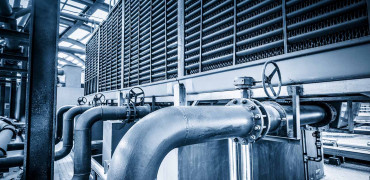We held our latest seminar last week, where we focused on decarbonising buildings as part of our 18-month-long campaign of events focusing ‘On the Road to Net Zero’.
This one was specifically targeted at the customers who specify equipment for buildings and looked at the challenges, and the opportunities from retrofitting commercial buildings to reduce their carbon impact.
And when you stop and consider that around 80% of the buildings that we will use and occupy by the time we reach the net zero target date of 2050, have already been built.
Many of these buildings are literally national treasures which we need to preserve but even if we wanted to knock them all down and start again, the carbon footprint from such a monumental construction project would far outweigh any benefits.
The key is measuring and looking at quick ways of optimising performance and carbon reduction
The manufacturer’s voice
Over 150 consultants attended the seminar looking at the net zero challenge in low carbon commercial retrofit.
They listened to presentations from senior stakeholders from the UK Green Building Council, Property Developer Savills and the Sustainability Supply Chain School along with our own experts, in an event aimed specifically at consultants and specifiers who wanted to find out more about carbon reduction plans, with a particular focus on low carbon commercial retrofit.
Our Commercial Product Group Director, Philip Ord started the presentations with an overview of Mitsubishi Electric’s own journey to net zero, followed by Chris Newman, our Zero Carbon Design Manager who spoke on the dangers of buildings becoming stranded assets unless they can improve their energy performance.
Chris has written on here before about the risk for building owners and managers of their buildings becoming stranded assets due to not reaching ever more stringent environmental standards.
Our white paper, ‘Stranded assets: A roadmap to net zero for new and existing buildings’ is also available to download for free and is designed to provide building owners and managers with more insight on the importance of setting up their buildings for net zero and describes methods on how they can achieve this.
The end of gas?
The Stranded Assets Guide also looks at the heating, ventilation and air conditioning (HVAC) systems that can help on the journey to net zero carbon emissions for both new and refurbished buildings. This includes the essential questions that clients should ask their design teams at the early stages of a project.
Many companies are already looking at ways to remove gas from their buildings and Chris Newman focused on bivalent systems which allow businesses to cost-effectively plan for this.
With digital HVAC and the Internet of Things (IoT) it is now possible to combine different technologies and systems to work together, so the presentation looked at the benefits of adding a heat pump to a building as a quick and straightforward way of reducing the carbon emissions from heating.
He presented two scenarios, first, where the heat pump works alongside the boiler, with them switching between themselves, depending on the load required and the outdoor temperatures.
This meant that there was no need to change the heat emitters and could still achieve carbon savings of up to 65%, making it an ideal first step to decarbonising a building.
Secondly, he looked at a bivalent system where the heat pump works in parallel to a boiler, where they share the load to offer but the heat pump heat share was very high to give the lowest overall carbon emissions.
Although this can be more difficult to integrate hydraulically, this can be overcome with careful system design looking at the flow temperatures and heat emitters.
This offers companies a step-by-step approach to introducing a full heat pump system with carefully planned transitions that account for the cost and equipment age.
UKGBC preliminary findings
This considered and planned approach was also advocated by the UK Green Building Council’s Senior Advisor, Anna Hollyman, who presented preliminary findings on the key opportunities and challenges of retrofit.
The UKGBC will be producing a special cost evaluation study into commercial retrofit measures in the New Year to offer guidance and advice on how companies can best prepare for net zero.
The key is to act now by measuring and looking at quick ways of optimising performance and carbon reduction.
This can then be followed by light retrofit to continue improvements in decarbonisation. Planning also allows building owners to look for natural chances for more greater interventions, such as changes of occupancy or the ending of a lease. This is when deeper retrofit measures can be planned to keep disruption to a minimum.
In essence, it’s about understanding your building, assessing what is required, and making as strong a business case ss possible, looking at all the barriers and reduction targets.
After the thought-provoking presentations and a stimulating Q&A session everyone was able to network on the roof terrace of the prestigious Institution of Engineering and Technology building with its stunning views of the London skyline and the Thames.
Graham Temple is a Marketing Manager for Mitsubishi Electric



